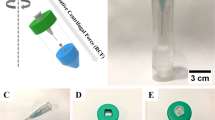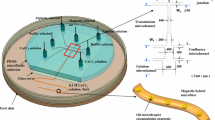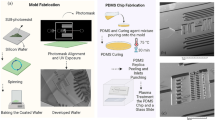Abstract
Microfabrication technique based on microelectronic technology is commonly used to produce microfluidic devices but this technique involves with costly and toxic chemicals. In this paper, we proposed the use of patterned adhesive vinyl template to produce a poly-dimethylsiloxane (PDMS) microfluidic device that was applied to generate microbeads of calcium alginate for microencapsulation of cells. In the microfluidic system, an infusion pump of high flow rate (2000 µl/min) and a commercial syringe pump were used to emulsify the continuous and disperse phases of liquids in forming the microbeads. Microbeads of calcium alginate in the range of 438 ± 38–799 ± 20 µm were successfully produced using this environmental friendly technique.
Access provided by CONRICYT-eBooks. Download conference paper PDF
Similar content being viewed by others
Keywords
1 Introduction
Microfluidic device is a widely use lab-on-chip that integrates a network of micro sized channels to execute special functions such as diluting [1], mixing and splitting of fluids [1, 2]. The main applications of the microfluidic devices are in the field of biomedical engineering, molecular biology and drug delivery [3]. Among the advantages of microfluidic device include processing accuracy, efficiency and minimum consumption of reagents [1]. The flow control of microfluidic device is predominantly involved with physics and engineering principles [4].
In soft lithography, the fabrication of the microfluidic device through the micropatterning of a silicon wafer requires clean room facility, costly masking methods and toxic chemicals. In our work, a technique was proposed to produce microfluidic device on a work bench based on adhesive vinyl template. The application of the microfluidic device in cell engineering was reported.
2 Materials and Methods
2.1 Design and Fabrication of the PDMS Microfluidic Device
The microfluidic pattern was designed in the COMSOL Multi physics software version 4.2 based on the requirements to perform emulsification at the crossed junction in which, the continuous (paraffin oil) and disperse (sodium alginate) phases were intersected. During emulsification, the minute droplets of the sodium alginate will be finely dispersed in the miscible oil phase. To perform emulsification in the microfluidic device, an inlet (inlet 1) with two split channels were assigned to induce two continuous flows of paraffin oil. At a crossed junction, the extensions of the two split channels then intercepted with the second inlet (inlet 2) assigned for disperse flow (sodium alginate). The three input channels were connected to an output channel leading to the outlet of the microfluidic device.
The design of the microfluidic template was plotted using Autocad® software (Autodesk®, service pack 1, USA). Then, the patterns on the vinyl sheet was plotted and cut using a vinyl plotter machine (Roland STIKA SV-12, Japan). Subsequently, a single layer of the patterned adhesive vinyl template was attached to a petri dish. Ten layers of similar patterned vinyl template were stacked to a thickness of 300 µm. The elastomer (Sylgard 184, Dow Corning, Michigan, USA) and curing agent (Dow Corning, Michigan, USA) were mixed at a ratio of 10:1 to produce poly-dimethylsiloxane (PDMS) gel. Then, the petri dish containing the vinyl template was filled up with the PDMS gel before curing in an oven at 70 °C for 1 h. After curing, the PDMS microfluidic device was peeled off and adhered to a glass slide. Holes were punched for the inlets and outlet of the microfluidic device.
2.2 Cell Culture and Preparation of Cell Suspensions
The human keratinocyte cell lines (HaCaT) were cultured in a 25 cm2 culture flask with Dulbecco’s Modified Eagle’s Medium (DMEM, Sigma Aldrich, Dorset, UK) supplemented with L-Glutamine (2 mM, Sigma-Aldrich, Dorset, UK), Penicillin (100 units/ml, Sigma Aldrich, Dorset, UK), Streptomycin (100 mg/ml, Sigma-Aldrich, Dorset, UK), Fungizone (2.5 mg/l, Sigma-Aldrich, Dorset, UK) and 10 % Fetal Calf Serum (Promocell, Heidelberg, Germany). The cells were incubated in an incubator at 37 °C and harvested using standard cell splitting procedure.
2.3 Cells Encapsulation in Calcium Alginate Microbeads
The sodium alginate and calcium chloride were prepared at a concentration of 2 and 5 %w/v, respectively. After the experimental setup as shown in Fig. 1, the HaCaT cells at a density of 82.8×104 cells/ml were mixed with 0.2 ml of sodium alginate and DMEM. The HaCaT cells containing in the sodium alginate solution were filled in a 5 ml syringe and infused into the microfluidic device as the disperse phase. Similarly, paraffin oil filled in a 5 ml syringe was infused to the microfluidic device as the continuous phase (Fig. 1). The calcium alginate microbeads encapsulated with HaCaT cells were polymerised in a sterilised petri dish containing the calcium chloride solution. The microbeads containing the cells were then incubated at 37 °C in a 5 % CO2 humidified incubator and monitored in an inverted phase contrast microscope (TS-100, Nikon, Tokyo, Japan). Images of the microcapsules were captured using a Go-3 camera (QImaging, Surrey, Canada). The cells in encapsulation were stained using 2 µg/ml of 4’,6-diamidino-2-phenylindole (DAPI, Sigma Aldrich, Dorset, UK) and then, observed in a fluorescence microscope (BX53, Olympus, Tokyo, Japan).
3 Results and Discussions
3.1 The Microfluidic Device
This is the first demonstration of producing microfluidic template using adhesive vinyl template as shown in Fig. 2a. However, the resolution limit was subjected to the resolution of the plotter at approximately 500 µm. Figure 2b shows the PDMS microfluidic device fabricated based on the patterned adhesive vinyl template for microencapsulation. The patterned adhesive vinyl template is reusable up to 20 times to fabricate PDMS microfluidic devices.
3.2 Size Distribution of the Microbeads
At a continuous flow rate of 2000 µl/min and disperse flow rates of 50 to 300 µl/min, the diameter of the microbeads produced were ranging from 438 ± 38 µm to 799 ± 20 µm (Fig. 3). The inset in Fig. 3 shows the microbeads of calcium alginate produced using the microfluidic device.
3.3 Encapsulation and Analysis of HaCaT Cells
Figure 4 shows the cells encapsulated and randomly scattered in a microcapsule with a diameter of 437 µm. DAPI staining provided a clearer indication on the distribution of the cells in the calcium alginate microbeads (Fig. 4b). The cell density applied was quite low in the range of 104 cells/ml. In order to achieve denser packing of cells in the microbeads, it was suggested to use a density of cells higher than 107 cells/ml [5]. A higher density of cells would stimulate the growth of micro tissues as demonstrated in [5, 6]. However, the microencapsulated cells in calcium alginate were successfully demonstrated using the developed microfluidic system.
4 Conclusion
A PDMS microfluidic device was designed based on adhesive vinyl template to perform emulsification of the continuous and disperse phases of two immiscible liquids. This technique enabled the fabrication of PDMS microfluidic without the use of toxic chemicals or expensive clean room facility. At a continuous phase fixed at 2000 µl/min and a disperse flow rates ranging from 50 to 200 µl/min, the microcapsules produced were determined at a minimum size of 438 ± 38 µm which was due to the size of the crossed junction of the microfluidic device. The developed microfluidic system was successful in microencapsulation of HaCaT cells in calcium alginate.
References
Hung, L.-H., Lee, A.P.: Microfluidic devices for the synthesis of nanoparticles and biomaterials. J. Med. Biol. Eng. 27(1), 1–6 (2007)
Duncanson, W.J., Lin, T., Abate, A.R., Seiffert, S., Shah, R., David, A.: Microfluidic synthesis of advanced microparticles for encapsulation and controlled release. Lab Chip 12, 2135–2145 (2012)
Nguyen, N.-T., Wereley, S.T.: Fundamentals and Applications of Microfluidics. Artech House, Norwood Incorporation, Boston (2009)
Björn, S., GPatrick, r., Göran, S.: A thermally responsive PDMS composite and its microfluidic applications. J. microelectromech. syst. 16 (1), 1057–7157 (2007)
Soon, C.F., Thong, K.T., Tee, K.S., Ismail, A.B., Denyer, M., Ahmad, M.K., Kong, Y.H., Vyomesh, P., Cheong, S.C.: A scaffoldless technique for self-generation of three-dimensional keratinospheroids on liquid crystal surfaces. Biotech. Histochem. 91(4), 283–295 (2016)
Wong, S.C., Soon, C.F., Leong, W.Y., Tee, K.S.: Flicking technique for microencapsulation of cells in calcium alginate leading to the microtissue formation. J. Microencapsul. 33(2), 162–172 (2016)
Acknowledgments
The authors would also like to thank financial support from Research Incentive Grant Scheme (IGSP Vot. U251) and Research Acculturation Grant Scheme (RACE Vot No. 1515) awarded by Malaysia Ministry of Education.
Author information
Authors and Affiliations
Corresponding author
Editor information
Editors and Affiliations
Rights and permissions
Copyright information
© 2017 Springer International Publishing AG
About this paper
Cite this paper
Soon, C.F., Yap, H.Y., Ahmad, M.K., Tee, K.S., Gan, S.H. (2017). Development of a Microfluidic Device System Using Adhesive Vinyl Template to Produce Calcium Alginate Microbeads for Microencapsulation of Cells. In: Jabłoński, R., Szewczyk, R. (eds) Recent Global Research and Education: Technological Challenges. Advances in Intelligent Systems and Computing, vol 519. Springer, Cham. https://doi.org/10.1007/978-3-319-46490-9_63
Download citation
DOI: https://doi.org/10.1007/978-3-319-46490-9_63
Published:
Publisher Name: Springer, Cham
Print ISBN: 978-3-319-46489-3
Online ISBN: 978-3-319-46490-9
eBook Packages: EngineeringEngineering (R0)








